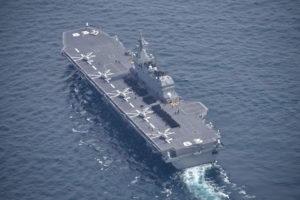by WorldTribune Staff, May 1, 2017
Japan is sending its hulking Izumo helicopter carrier to secure passage of a U.S. Navy supply ship as Prime Minister Shinzo Abe expands the scope of Self-Defense Forces activities amid the rising threat from North Korea.
Following an order from Defense Minister Tomomi Inada, the 249-meter-long Izumo will help protect the U.S. vessel as it transits waters off the Boso Peninsula to an area off Shikoku, Reuters reported on April 30.

The Izumo may also provide fuel and other supplies for ships in the USS Carl Vinson aircraft carrier strike group, which arrived in the East Sea (also known as Sea of Japan) over the weekend amid growing tensions over the North Korean nuclear crisis.
In London on April 29, Abe slammed North Korea for test-firing a missile earlier in the day.
“Despite strong warnings by the international community, North Korea today went through its ballistic missile launch. It is a grave threat to our country. This is absolutely not acceptable. We strongly condemn such acts,” Abe told reporters.
“As prime minister I am focusing on China’s response,” Abe added. “China, I hope, will play a constructive role . . . it is my high expectation that China will perform its role properly.”
The largest vessel in Japan’s navy, the Izumo is as large as Japan’s WWII-era aircraft carriers and can operate up to nine helicopters. The government has designated the Izumo as a destroyer because the Constitution forbids the acquisition of offensive weapons.
Japan’s Self-Defense Forces were assigned with guarding U.S. warships during peacetime under new security laws enacted in March 2016. The laws enable Japan to exercise the right to collective self-defense, or coming to the aid of an ally under attack, and expand the scope of SDF activities overseas, the report said.
The SDF was previously allowed to defend its own aircraft and vessels, but the laws expanded the scope of protection to include the military equipment of the U.S. and other countries with close security ties to Japan.
